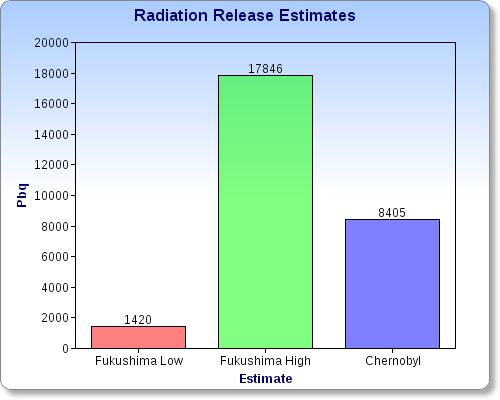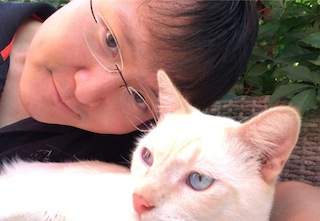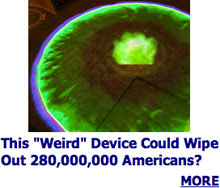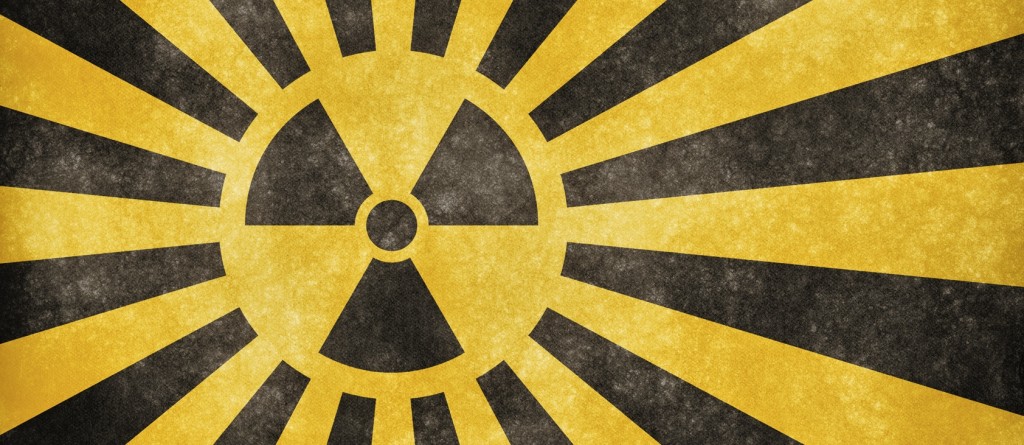“To him who looks upon the world rationally, the world in its turn presents a rational aspect. The relation is mutual.” – GWF Hegel
Although there are ongoing dangers at Fukushima Nuclear Power Plant #1 (FNPP#1) which continues to leak radiation into the air and water, it is often forgotten that by far the worst devastation from the accident occurred at the time of the triple meltdowns in the week of the 3/11 (March 11, 2011) earthquake and tsunami in Japan. The radiation from that event is still lingering in the local environment and will be here for hundreds of years. The corium is emitting massive radiation which makes it impossible for human workers to remove it for safer storage.
It is doubtful that Fukushima is still fissioning given the lack of evidence of the types of radioisotopes you would find as evidence of that occurring. Also, we have heard much about the “failure” of the ice wall to prevent the leakage of radiation from the plant. However, although it has taken a long time the cost and long term viability are not clear, it does appear, despite what Arnie Gundersen stated in his latest video, the ice wall may soon become functional, despite the gloomy headline below:
Underground temperature never go down regardless of frozen wall beside common fuel pool
http://fukushima-diary.com/2015/08/underground-temperature-never-go-down-regardless-of-frozen-wall-beside-common-fuel-pool/
Tepco may also be planning to build a wall to close off the port to the ocean and filter the water that goes to sea. If the ice wall can work, if they can filter water that escapes the port of most of the radioactive elements (other than perhaps tritium), and if robots can eventually locate and remove the melted fuel in the reactors, we may be on the way to some sort of real decommissioning. That is a lot of “ifs” and “maybes” folks.
Nagoya Uni “Significantly small amount of fuel remaining in Reactor 2” / No announcement about underground
http://fukushima-diary.com/2015/03/nagoya-uni-significantly-small-amount-of-fuel-remaining-in-reactor-2-no-announcement-about-underground-situation/
Radiation Concerns
As an inhabitant of Tokyo, Japan, I am still very concerned about my own personal health and the health of my family members, not to mention the effects of the massive release of radiation that occurred after 3/11 which physically touched 60 million of my neighbors in the Tokyo and surrounding regions. For example, since Tokyo itself was never decontaminated, the original radiation that blanketed the city remains circulating in the soil, water and air. We know this because there are any number of radioactive hotspots in gutters and drainage areas, and vacuum cleaners in average homes have been reported to collect substantially radioactive dust.
Over 80 Bq/Kg of Cesium-137 detected from vacuum cleaner dust used since this Spring in Tokyo
http://fukushima-diary.com/2015/08/over-80-bqkg-of-cesium-137-detected-from-vacuum-cleaner-dust-used-since-this-spring-in-tokyo/
In November of 2012 one independent research group found 1,270 becquerels of cesium per kilogram from house dust collected from vacuum cleaners in Chiba prefecture, which is just adjacent to Tokyo.
Results of ACRO’s monitoring in Japan (6th of march 2013 update)
http://www.acro.eu.org/Archives/OCJ_en.html#48
 I could find no similar research from the government or independent NGOs more recently. However, one sampling in 2011 found shocking levels of cesium in house dust in Tokyo itself due to the fallout from the accident.
I could find no similar research from the government or independent NGOs more recently. However, one sampling in 2011 found shocking levels of cesium in house dust in Tokyo itself due to the fallout from the accident.
Journalist finds Tokyo indoor dust contaminated with cesium at 1,730 Bq/kg — Scientist: Dust with Fukushima fallout is the source of human radiation exposure (VIDEO)
http://enenews.com/journalist-cesium-tokyo-indoor-dust-measured-1730-bqkg
If we compare recent measurements with 2011 the amount has decreased considerably, but still remains in disturbing quantities. Of course, these are isolated samplings and the government itself does not supply such data.
Since there is no comprehensive scientific investigation into the levels of radiation in the Tokyo region, we are mainly left in the dark on this issue.
For example, these academic research papers expose the layers of deception that the government has created in order to hide the truth about Fukushima radiation dangers, with the second article predicting that 5,000 cancer deaths will occur due to Fukushima radiation:
Demystifying the Official Discourse on Childhood Thyroid Cancer in Fukushima
http://japanfocus.org/-Piers-_Williamson/4232/article.html
Fukushima: Thousands Have Died, Thousands More Will Die
http://www.globalresearch.ca/fukushima-thousands-have-died-thousands-more-will-die/5469979
Not Out Of The Woods
In the meantime Japan has restarted the Sendai nuclear power plant in Kyushu which is surrounded by active volcanoes, and if there were to be a major eruption it could cause emergency electricity supplies for the plant to be lost, theoretically leading to a meltdown there (as opposed to a lava flow!). Japan also wants to restart reactors in Niigata despite Tepco’s terrible safety record at the Kashiwazaki plant and the Governor of Niigata’s stiff opposition to a premature restart. Niigata is famous for growing some of Japan’s most prized rice crops. Radioactive rice anyone? In 2013 Japan’s Prime Minister Shinzo Abe bragged about how he loves to eat rice from Fukushima.
Oh, and by the way, even the pro-nuclear New York Times ran an essay which posits that Japan’s plutonium stockpile could result in an unprecedented catastrophe for the entire world if an earthquake were to occur at the reprocessing plant, which does indeed have a fault line running in its vicinity. Ho hum la dee dah.
Japan’s Plutonium Problem
http://www.nytimes.com/2015/08/17/opinion/japans-plutonium-problem.html
Sound The Alarm
 I was recently a guest on the Jeff Rense radio program with another guest, Dana Durnford, who is an experienced ocean shell diver and knowledgeable ecologist familiar with the western coastal waters off Canada in the province of British Columbia.
I was recently a guest on the Jeff Rense radio program with another guest, Dana Durnford, who is an experienced ocean shell diver and knowledgeable ecologist familiar with the western coastal waters off Canada in the province of British Columbia.
Although Durnford has many supporters in his work to monitor the ongoing sea life crisis and die-offs occurring there, he raised the point that the public in general has little understanding or awareness of the radiation issue. Surely one of the reasons is the selective way in which government agencies and the media (in cahoots with the nuclear industry) choose to report data.
In Japan, Tokyo Electric Power Company (Tepco, by far Japan’s largest utility company) and the Nuclear Regulatory Agency (NRA) publish data, but that data does not gain wide circulation in the media or the consciousness of average people in Japan.
Comparing The Disaster Data
The public has been taught to think only about cesium, when there are somewhere between 200 to a thousand other types of artificial radioisotopes that are created by nuclear reactors. Even dangerous elements such as Iodine 129 and 131 last for months before decaying to non detectable (ND) levels. Tritium is treated as “no big deal” despite being relatively dangerous and a regular effluent from the normal operations of nuclear plants due to the impossibility of filtering it. Plutonium, the world’s most deadly substance lasts for millions of years. A substance never known in the existence of nature before its artificial creation for the purpose of making nuclear weapons, and as a by product of the nuclear fission process to produce energy (that’s one helluva a way to boil water).
Let’s review the total amount of radiation that was released from Fukushima accident in the week after 311. As nuclear expert Arnie Gundersen has reported:
Nuclear Containment Risk
http://www.fairewinds.org/nuclear-energy-education/nuclear-containment-risk
Recent scientific studies from Japan show that 75% of the radiation created by the meltdowns was released more than 5 days after the catastrophe, while only 25% of the radiation was released during the first 4 days. This data, which is posted on the fairewinds.org website, shows that the total gaseous and liquid radioactive releases from the Fukushima Daiichi meltdown exceed the radiation released during and after the Chernobyl meltdown, while Fukushima Daiichi radioactivity continues to bleed into the Pacific Ocean.
The informative website Simply Info (SI) produced a useful comparison of radiation ranges:
New Fukushima Radiation Release Estimates Compiled
http://www.fukuleaks.org/web/?p=11668
SI compared the range of estimates from low to high for Fukushima radiation vs Chernobyl (one agreed upon figure). As we see in the chart below, if you take the low number, measuring in petabecquerels (peta = a quadrillion, 1,000,000,000,000,000), the lowest estimate, is almost a sixth, or about 17 percent as great as Chernobyl. The higher estimate is over twice as great as Chernobyl. If we split the difference Fukushima was still higher at 8,923 petabecquerels. By comparison Chernobyl is largely contained (entombed). Fukushima also used plutonium laced MOX fuel in at least one of its reactors (no. 3) which is the one that blew sky-high.
 One estimate put cesium from the accident at 181 quadrillion becquerels.
One estimate put cesium from the accident at 181 quadrillion becquerels.
Fukushima released up to 181 Quadrillion Bq of cesium
http://enenews.com/govt-report-fukushima-already-released-181-quadrillion-bq-cesium-chernobyl-estimated-105-quadrillion-radioactive-material-continue-flowing-ocean-years-fukushima-radionuclides-spread-north-pac
In addition, the amount Fukushima continues to release is not insignificant whether by sea or by air as these fairly recent reports note:
Fukushima Daiichi Still Releases 10 Million Becquerels Per Hour – “TEPCO admitted today that the plant is still releasing 10 million becquerels per hour to the atmosphere.” http://www.fukuleaks.org/web/?p=13487
Fukushima Daiichi Sea Releases Updated To 157 Billion Bq Per Day
http://www.fukuleaks.org/web/?p=13705
Although these numbers sound shockingly high, in comparison to the original accident they are quite small and it would take many decades of releases at this rate to add significantly to the total amount that was originally released. Nevertheless, it should be remembered that there is no known safe level of radiation.
Unknown Effects Of Lesser Known Isotopes
 Of course, the main radioisotope that most people are aware of and indeed is dangerous due to its radioactivity and longevity in the environment is cesium, both in the forms of CS-134 and CS1-137.
Of course, the main radioisotope that most people are aware of and indeed is dangerous due to its radioactivity and longevity in the environment is cesium, both in the forms of CS-134 and CS1-137.
Other isotopes of concern are tritium, strontium, uranium and plutonium.
I have read that there are anywhere between 200 up to a thousand radioisotopes that were released from Fukushima. Wikipedia lists 901 nuclides could be released from the fissioning process.
List of nuclides
https://en.wikipedia.org/wiki/List_of_nuclides
Our friend Nancy Foust of the Simply Info website who has supplied many important technical insights to my articles in the past offered some of these relevant observations in a personal communication:
There should be some study of other long lived isotopes to determine what else is potentially in the environment. There are many older studies and reporting on uptake into various plants and animals of different isotopes. So if one is found to exist in the environment in detectable quantities it could be cross referenced to the plant life and animals that could be impacted to see if there is some merit to further study.
A good example of this is cephalapods like octopus which can uptake plutonium and americium. This is something I have not seen testing or research for related to Fukushima even though octopus was being declared safe as it doesn’t uptake cesium easily like some of the bottom feeder fish do.
octopus americium
https://www.google.com/search?q=octopus+americium&oq=octopus+americium+&aqs=chrome..69i57.7606j0j7&sourceid=chrome&es_sm=93&ie=UTF-8….there are some real knowledge gaps about what was released and where.
I asked her about the possibility that Fukushima is still in a process of ongoing fissioning:
TEPCO monitors for Xenon 135 as an indicator of fission. There were detections a few years back at unit 2. Xenon readings are reported daily. Currently units 2 and 3 show none detected. Unit 1 shows a reading but it is below the minimum detection amount. So it is below the margin of error meaning it could be instrument oddity or readings so low they can’t confirm them.
Fukushima Daiichi Nuclear Power Station Plant Parameters As of 5:00 on August 24 2015
http://www.tepco.co.jp/en/nu/fukushima-np/f1/pla/2015/images/table_summary-e.pdfWhen the fuel cools and solidifies it is assumed to stop fissioning. Of course it can still give off strong radiation. So it is hard to know for sure. Identifying exactly where the fuel is and the state of it would give a much better idea. If they can reach the area they could also install probes to look for neutrons or Xenon 135 activity.
 There seems to have been some confusion on this matter and you even come across an article here and there that mentions evidence of fissioning due to the detection of iodine.
There seems to have been some confusion on this matter and you even come across an article here and there that mentions evidence of fissioning due to the detection of iodine.
STILL ONGOING FISSION: Over 1,000 Bq/Kg of I-131 measured from sewage sludge in Northern part of Fukushima prefecture
http://fukushimaemergencywhatcanwedo.blogspot.jp/2014/07/still-ongoing-fission-over-1000-bqkg-of.html
However, according to Foust:
The iodine 131 thing is a big maybe. What mucks it up is the medical use of iodine 131. This became apparent in the US right after Fukushima when iodine 131 was detected in a river out east. The government admitted it was discharge from a hospital that was treating patients with iodine 131.
The pathways where medical use iodine 131 shows up is usually in municipal sewage systems. It will sometimes show up in surface water as a persistent contaminant where it makes it through the sewage treatment process and is detected in the waterway.
There was a finding in Chiba in the last year or so where iodine 131 was found I think it was in the river. I looked up the town it was found in and there was a hospital in the town that had a department that did iodine 131 therapy. So there was the potential that in that incident it was due to medical use.
If iodine 131 is found in the air, soil, or food that would be of more concern, it would much less likely to be caused by medical iodine 131 use.
I checked the archives at Fukushima Diary:
Iodine 131
http://fukushima-diary.com/?s=iodine+131
Iodine
http://fukushima-diary.com/?s=iodine
Most of the articles do appear to be related to sewer sludge (which would indicate the source is from medical sources and not from fissioning), but astute readers may find exceptions. One article from 2012 reported iodine in well water near the disaster site but no indication of cesium, and there has been no follow up report.
ChimpZoo ApeBoy W/ Godzilla Breath vs Gentle Engineer And Cat
VS
Fukushima Diary
http://fukushima-diary.com
 One has to wonder about the mental faculties of the Japanese Prime Minister Shinzo Abe, who graduated from a mediocre university; dropped out when he couldn’t hack the standards at a California university; lied about Fukushima being under control in order to get the Olympics bid; and most recently admitted he does not know much about Japan’s surrender at the end of World War II. The last point is relevant because his administration is aggressively remilitarizing Japan against the majority of public opinion. Radiation information has been censored by government and media in Japan due to pressure from the Abe administration.
One has to wonder about the mental faculties of the Japanese Prime Minister Shinzo Abe, who graduated from a mediocre university; dropped out when he couldn’t hack the standards at a California university; lied about Fukushima being under control in order to get the Olympics bid; and most recently admitted he does not know much about Japan’s surrender at the end of World War II. The last point is relevant because his administration is aggressively remilitarizing Japan against the majority of public opinion. Radiation information has been censored by government and media in Japan due to pressure from the Abe administration.
JCP’s Shii: Abe has never read the Potsdam Declaration
http://ajw.asahi.com/article/behind_news/politics/AJ201505220045
Here is a pointed but accurate portrayal and history of Abe the Bonobo Banana Boy (ABBBy):
SEIKEI UNIVERSITY – 2015 University web ranking 3060 – 2015 Rank in Japan 103. Seikei University was not even accredited when Abe was enrolled there as an undergraduate student. Seikei did not receive accreditation from the Ministry of Education, Culture, Sports, Science and Technology, until 1981. Why is such a well-educated populace as Japan’s voting for a proven idiot? Because Japan is not a democracy.
http://www.4icu.org/reviews/2844.htm
‘Supreme Commander’ (saikō shikikan)
Abe arrived at Seikei University in the traditional Japanese style of school-recommendation – by not falling off the student conveyor belt of its feeder schools Seikei Elementary School, Seikei Junior High School, and Seikei Senior High School. He studied political science at (the then non-accredited) Seikei University in Tokyo, graduating in 1977 with a BA Political Science & Public Policy – his one and only completed endeavour to date. He then laid the foundations of his future career by dropping out of the University of Southern California’s School of Public Policy after only three semesters in 1979.
His skulking departure from office in 2007 again demonstrated his spineless nature, in addition to revealing the magnitude of his ineptitude, exemplifying him as the perfect example of that most revered Japanese quality of being ‘unique’.
http://www.plaidavenger.com/leaders/profile/shinzo-abe/
https://en.wikipedia.org/wiki/Shinzo_Abe
This time around he is incredibly adding to his ‘uniqueness’ as a third-generation warmongering wannabe war criminal ever more likely to get the conflict he so cravenly desires.
(source wishes to remain anonymous).
* (To be fair to poor ole ChimpZoo ApeBoy there are other baboons and capo brutto of floundering nation states who deserve a good skewering. Several months ago I wrote an article in which I said some kind things about President Jimmy Carter. It was very stupid of me. I had praised him for writing a book critical of Israel forgetting about uglier aspects of Carter’s history. Now that Carter is approaching the end of his long life, it is time for the truth to come out about how he helped lead to the decline of America. See: The Real Jimmy Carter: A toothy sanctimonious fake
http://www.tomatobubble.com/jimmy_carter.html)
 It is well documented that Abe’s administration has pressured Japan to restart the nuclear reactors and has impeded the pathway to a cleaner energy future. I remember when the NRA was first established after the accident — there were many critical voices in its members — now they have a more muddled approach and set their sights on restarting a number of Japan’s reactors.
It is well documented that Abe’s administration has pressured Japan to restart the nuclear reactors and has impeded the pathway to a cleaner energy future. I remember when the NRA was first established after the accident — there were many critical voices in its members — now they have a more muddled approach and set their sights on restarting a number of Japan’s reactors.
One tactic for doing that is by downplaying the severity of the Fukushima accident, and by dismissing radiation as harmless or at worst minimal concern.
If we compare the data from the NRA vs independent sources like Fukushima Diary (FD) and other citizen groups what we come away with are two very different interpretations of reality.
Taken at face value, there is quite a range of potentially valuable information regarding radiation distribution patterns in Japan at the NRA website:
Nuclear Regulation Authority
https://www.nsr.go.jp/english/index.html
I could not find a simple explanation of the method (i.e., type of equipment and how measurements are taken) for collecting data. If they are using honest methods, this would indicate that much of the radiation from the accident has “gone away.”
There may be technical or scientific tricks afoot, or the radiation has indeed declined over the last 4 years, despite ongoing emissions from the accident site.
One might ask if they are providing data with the hopes of finding the result they hope for. I personally witnessed a monitoring station in a town near the accident site which reported very low measurements of radiation, but the area around the monitoring station had been decontaminated while just a hundred meters away went up ton 2.0 mcr.sv.pr hr. on the ground. If the results at the NRA site are taken in the same disingenuous way as I personally witnessed, then we cannot trust any of their data.
Japan’s Radioactive Potemkin Village: The Government’s Double-Dealing Data
https://www.activistpost.com/2014/04/japans-radioactive-potemkin-village.html
When it comes to NRA radiation monitoring, I could not find any methodological explanation here either, just a “we are experts — trust us” feel to the website, a typically smug attitude of those in power.
Monitoring
http://radioactivity.nsr.go.jp/en/
This FD archive tells a much different story about the ongoing radiation leakage from the plant than one would glean from the difficult-to-discern documents at the NRA website:
Contaminated Water Crisis
http://fukushima-diary.com/fukushima-plant-2/contaminated-water-crisis/
And yet, the NRA does report that while most of Japan rates radiation in drinking water as ND, Tokyo does, with a relatively high amount of CS-137 compared to other readings. I would bet 99 percent of Japanese have no clue or would bristle with resentment if they were informed of this fact that is NEVER reported in the mainstream media.
Readings of radioactivity level in drinking water by prefecture – April-Jun, 2015
http://radioactivity.nsr.go.jp/en/contents/11000/10073/24/194_20150731.pdf
 Take the example of radiation readings in the Fukushima port. Here is a chart that actually shows a photo of the Dai-ichi site, and claims levels of cesium are ND, although other charts at NRA show exact measurements where cesium is detectable — but so low as to be judged ND.
Take the example of radiation readings in the Fukushima port. Here is a chart that actually shows a photo of the Dai-ichi site, and claims levels of cesium are ND, although other charts at NRA show exact measurements where cesium is detectable — but so low as to be judged ND.
Monitoring of seawater at Units 1 – 4, August 2015
https://www.nsr.go.jp/data/000118105.pdf
Many more data points:
Readings of Sea Area Monitoring
http://radioactivity.nsr.go.jp/en/
How on Earth could the ND readings be true given the massive amount of radiation released into the water?
Nancy Foust of Simply Info:
Curious isn’t it? TEPCO and NRA have consistent ND readings at or near the plant for water monitoring. Workers who have posted on twitter since the disaster have accused TEPCO of gaming their fish testing. They claimed they were either throwing out some fish or throwing out some of the results. Given TEPCO’s track record for dishonesty such a thing would not be a surprise.”
23,900 Bq/Kg of Cs-134/137 still measured from fish in Fukushima plant port
http://fukushima-diary.com/2015/08/23900-bqkg-of-cs-134137-still-measured-from-fish-in-fukushima-plant-port/At the plant there have been areas in the sea front where radiation readings were in the millions of bq/liter. We have seen those kinds of readings rise and later fall. So that contaminated water has to be going somewhere. Yet the port and the nearby sea readings will show little or no radiation. One possible explanation could be the strong current in the area. If the current is quickly dispersing the contamination that could lead to lower readings. Another possibility is that most of the leaking is happening further out to sea or some other similar route that is missed.
I do remember is 2011 TEPCO was coming back with some absurd low readings in sea water. They were taking surface only readings, this ignored what might be in the lower levels of the water. This again could be the case if readings are taken only at the surface. Some of the oceanographic testing out in the Pacific has looked for contamination at different depths. So this is another potential way some readings may not give the full story.
Where have all the becquerels gone?
Highest Strontium-90 density detected in seawater of Fukushima plant port / 1,500,000 Bq/m
http://fukushima-diary.com/2015/07/highest-strontium-90-density-detected-in-seawater-of-fukushima-plant-port-1500000-bqm3/
1,000,000 Bq/m3 of Sr-90 detected in seawater of Fukushima plant port / Highest in recorded history
http://fukushima-diary.com/2015/06/1000000-bqm3-of-sr-90-detected-in-seawater-of-fukushima-plant-port-highest-in-recorded-history/
5 Billion Bq of Strontium-90 flows to the sea every single day
http://fukushima-diary.com/2014/08/5-billion-bq-strontium-90-flows-sea-every-single-day/
2,200,000,000,000 Bq of All β nuclides leaked to the Pacific in the recent 314 da
http://fukushima-diary.com/2015/03/2200000000000-bq-of-all-β-nuclides-leaked-to-the-pacific-in-the-recent-314-days/
NRA’s airborne radiation monitoring appears to have ended in 2013:
Reading of Land Monitoring
http://radioactivity.nsr.go.jp/en/list/313/list-1.html
What you don’t know won’t hurt you?
One trillion Bq released by nuclear debris removal
http://www.fukuleaks.org/web/wp-content/uploads/2014/07/One-trillion-Bq-released-by-nuclear-debris-removal-NHK-WORLD-English-.pdf
According to NRA readings there were increases from BEFORE the accident to present day, but even in Fukushima prefecture they are quite small differences. Perhaps this is due in part to the fact that 70 percent of the radiation released from Fukushima, which may have been over double the amount released from Chernobyl, went out to sea thanks to wind directions at the time.
Radiation by prefecture, August 2015
http://radioactivity.nsr.go.jp/en/contents/11000/10137/24/192_20150816_20150817.pdf
In Iwate prefecture, for example, radiation in rivers there was normally below one bq per liter in this chart:
The Results of Radioactive Material Monitoring of the Surface Water Bodies within Iwate Prefecture
http://www.env.go.jp/en/water/rmms/attach/result_pw01_iwate009.pdf
Compare this FD archive which documents ongoing radioactive contamination of the environment:
Environmental Contamination
http://fukushima-diary.com/fukushima-plant-2/environmental-contamination/
Hotspots like the one below are fairly common but are not recorded on the NRA database:
Still over 4 μSv/h measured in a park of Nasushiobara city
http://fukushima-diary.com/2015/08/still-over-4-μsvh-measured-in-a-park-of-nasushiobara-city/
You decide. Who should your trust, the government or the citizen activists? Unfortunately the government and corporations which own and control the media have the ability to whitewash damaging information; measure radiation in very selective and slick ways; and downplay the harmful effects of radiation by using dodging epidemiological science as promulgated by the IAEA nuclear establishment.
Richard Wilcox is a contributing editor and writer for the book: Fukushima: Dispossession or Denuclearization? (2014) and a Tokyo-based teacher and writer who holds a PhD in environmental studies. He is a regular contributor to the world’s leading website exposing the Fukushima nuclear disaster, Rense.com, and a regular contributor to Activist Post. His radio interviews and articles are archived at http://wilcoxrb99.wordpress.com and he can be reached at wilcoxrb2013@gmail.com.



It seems there is more to this ConsPiracy than just the ongoing cover up. Opening new fission reactors all over quake prone Japan is so monumentaly, obviously stupid (and obsolete, and unnecessary) it beggars belief. No wonder they need an idiot prime minister in office. It seems to me the Pirate Kings aren’t yet finished with the nuking of the Japanese.
Well said Richard, although I personally think fissioning still continues because of iodine-131 detections.
Could be. To tell the truth I did not examine every case of iodine being found but assumed from the ones I saw that many were related to hospitals. Go back and read Nancy’s comments again, she works with engineers and is good at explaining these sorts of things to the rest of us.
Of course Tipkill could be lying about not detecting any xenon since it would be in their interest to cover this up and make the situation look rosier than it is — lyin’ bastards that they are. If anyone has any convincing data that it is still fissioning please let us all know and post a comment here! Thanks!
And for the record, some time ago I wrote an article throwing water on the idea that the ice wall will work. It appears that it will work. How well and how inexpensively is another question. I imagine there will be many technical problems and how many years it will have to operate…
– Richard Wilcox
Few things are more irritating than stubborn stupidity, which most of the governments of the world exhibit regarding Fukushima! They are all complicit in the denial of the slow but sure degrading of our biosphere because of the radiation emitting from Japan.